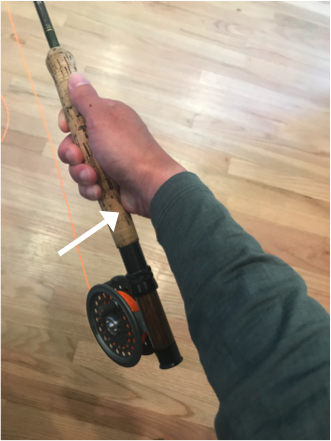In single-handed fly casting, the most popular grip places the thumb on top of the rod handle. These casters use the bones in the thumb to push the rod handle as if it were a thumbtack. The grip seems like a logical choice. It also feels comfortable and powerful, especially for a forward cast.
The thumb-on-top grip.
But… What Bones Are Used To Stop The Front Cast?
When the rod is accelerated to a hard stop at the end of a forward cast, the handle pivots in the caster’s hand, and the rod’s pressure point switches from the thumb to the bottom of the hand. Instead of hitting a bony area, the handle presses against a fatty part in the heel of the hand.
The thumb-on-top grip from a second perspective. Notice that this grip places a fat pad on top of the handle. :(
The lack of a bony surface decelerates the rod slowly, robbing the front cast of distance. The often-used analogy of flicking paint off a brush may be of help. To fling paint off of the bristles as far as possible, the key is to decelerate the brush abruptly: the quicker the stop, the farther the paint is flung forward. To a similar extent, the faster a rod is stopped, the more energy is transferred to the line.
“The transfer of energy is more efficient between two hard surfaces
Than a hard surface and a soft one.”
And… What Bones Are Used to Make a Back Cast?
When a forceful back cast is made with a thumb-on-top grip, again, there is no bone to press against the lower (butt) end of the handle. Instead, the fatty area in the heel of the hand must rotate the rod handle up. This problem is highlighted when we try to lift or rotate the rod up against some pressure to mimic a back cast or a hook set. There’s play – as if the handle were made of sponge — and the play is exaggerated in longer rods.
The use of a fatty area to make a back cast is a critical problem for thumb-on-top casters. If trajectories of the front and back casts need to be 180 degrees apart, for most fishing distances the back cast would be directed up (against gravity) and the front cast would be directed down (with gravity). This means that the caster must apply greater forces during the back cast compared to the front cast because the back cast is working against gravity and the front cast is working with gravity.
Since trajectories for the front and back casts should be 180 degrees apart, the back cast must be directed slightly upwards — against gravity — while the front cast must be directed slightly downwards — with gravity.
Yet, thumb-on-top casters use a harder surface of the hand (thumb) to make a less forceful part of a cast (front stroke) and a softer surface (heel of hand) for a more forceful part of the cast (back stroke). It doesn’t make sense.
What Does This Mean?
To stop the rod quickly at the end of the front cast and to make a powerful back cast, thumb-on-top casters must grip the rod forcefully during these parts of the cast. In essence, they must expend energy and compress the fat pad in an attempt to make energy transfer more efficient. It’s tiring!
Tensed muscles and numb fingers make subsequent dampening of the rod more difficult since they are not as fast as relaxed muscles (barely gripping the handle), waiting to dampen or absorb the counterflex of the rod.
The Bottom Line
Since thumb-on-top casters have to grip the handle tightly during much of the cast, their hands are more likely to become tired, numb, and painful. As a result, the thumb-on-top grip is not the most efficient grip.


